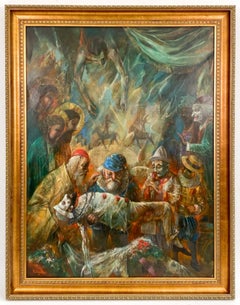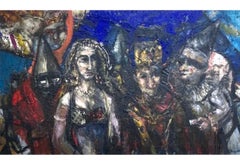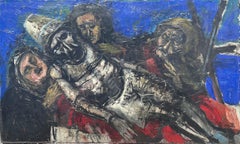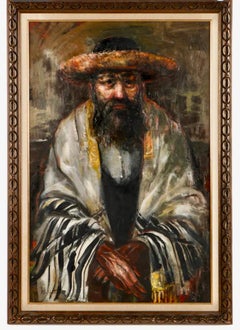Want more images or videos?
Request additional images or videos from the seller
1 of 16
Jonah KinigsteinLarge Figurative Expressionist Oil Painting Rediscovered New York City Artistc.1950's
c.1950's
$4,500List Price
About the Item
- Creator:Jonah Kinigstein (1923, American)
- Creation Year:c.1950's
- Dimensions:Height: 36 in (91.44 cm)Width: 60 in (152.4 cm)
- Medium:
- Movement & Style:
- Period:
- Condition:good. needs new frame. this is being sold unframed.
- Gallery Location:Surfside, FL
- Reference Number:1stDibs: LU38210470982
About the Seller
4.9
Platinum Seller
Premium sellers with a 4.7+ rating and 24-hour response times
Established in 1995
1stDibs seller since 2014
1,810 sales on 1stDibs
Typical response time: 1 hour
Authenticity Guarantee
In the unlikely event there’s an issue with an item’s authenticity, contact us within 1 year for a full refund. DetailsMoney-Back Guarantee
If your item is not as described, is damaged in transit, or does not arrive, contact us within 7 days for a full refund. Details24-Hour Cancellation
You have a 24-hour grace period in which to reconsider your purchase, with no questions asked.Vetted Professional Sellers
Our world-class sellers must adhere to strict standards for service and quality, maintaining the integrity of our listings.Price-Match Guarantee
If you find that a seller listed the same item for a lower price elsewhere, we’ll match it.Trusted Global Delivery
Our best-in-class carrier network provides specialized shipping options worldwide, including custom delivery.You May Also Like
"Portrait of Truman Capote" by John MacWhinnie
By John MacWhinnie
Located in Long Island City, NY
Artist: John MacWhinnie, American (1946 - )
Title: Portrait of Truman Capote
Year: 1968
Medium: Mixed Media on Board (Oil and Pencil), signed and dated l.r.
Size: 23.5 x 18 inches
Fr...
Category
1960s Expressionist Portrait Paintings
Materials
Mixed Media, Oil, Board, Pencil
$25,000
H 27.5 in W 21.5 in D 2 in
'Zulu Dancers'
Located in Amsterdam, NL
‘Zulu Dancers’
Signed bottom right Hardman, titled on a sticker at the reverse and with address Walton End, Walton Lane, Bosham, Chichester, and Price 45 gns.
Oil on board, 99 x 87...
Category
20th Century Expressionist Nude Paintings
Materials
Oil, Board
$8,960 Sale Price
48% Off
Free Shipping
H 38.98 in W 34.26 in D 1.58 in
At the autumn garden. Oil on cardboard, 80 x 57 cm
Located in Riga, LV
At the autumn garden. Oil on cardboard, 80x57 cm
Janis Rikmanis (1901.5.IV – 1968.25.III)
graduated Figurative painting studio of Latvia Art academy (1931).
He took part in exhibiti...
Category
1950s Expressionist Portrait Paintings
Materials
Oil, Cardboard
$1,534 Sale Price
20% Off
H 31.5 in W 22.45 in D 0.04 in
At the Theatre
By Donald Roy Purdy
Located in New York, NY
Born in 1924 Donald Purdy in the 1960s did a series of works on clay-coated paper. He loved working in this medium and he would apply oil paint and then rub it away with a cloth to ...
Category
Mid-20th Century Expressionist Portrait Paintings
Materials
Clay, Oil, Board
Resting, Expressionist Portrait of Young Man by Philadelphia Artist
By Bernard Harmon
Located in Doylestown, PA
"Resting" is an interior portrait of a young man resting on a sofa. This work was painted by Philadelphia born Expressionist painter Bernard Harmon. The 24" x 32" oil on board painti...
Category
1960s Expressionist Portrait Paintings
Materials
Oil, Board
$15,000
H 30 in W 38 in D 1.5 in
Snap Peas, Expressionist Portrait of Young Woman by Philadelphia Artist
By Bernard Harmon
Located in Doylestown, PA
"Snap Peas" is an interior portrait of a young woman working at her kitchen table, painted by Philadelphia born Expressionist painter Bernard Harmon. The 24" x 36" oil on board painting from 1955 is signed "Harmon" in the lower left and it is framed in a new black wood frame. Figurative expressionism in the style of Alice Neel.
Bernard Harmon was born in Philadelphia, Pennsylvania in 1935. Harmon was primarily a portrait painter and a well loved teacher in the Philadelphia area. A graduate of the Philadelphia Museum School and Temples Tyler School of Art, Harmon traveled extensively in Europe and South America. Beloved by many, Harmon taught in the Philadelphia School District for 32 of his 54 years of life. Beginning his career as an art teacher at West Philadelphia High School, in the early 1960s he became one of the district's artists in residence, traveling from school to school to demonstrate for students how an artist works. Returning to the classroom, Harmon joined the art department at Central High School where he taught for 14 years and became an innovator in art curriculum, developing a program offering advanced placement art classes to gifted students. In his final years Harmon became a supervisor, mentoring teachers and overseeing programs in the Philadelphia school systems District #1. During his short life Harmon taught collage preparatory art classes at the Pennsylvania Academy of the Fine Arts, summer classes at the University of the Arts, and a Saturday program for gifted children at Drexel University. Among Harmon's portraits were commissioned by Philadelphia Jazz organist Jimmy Smith and Mayor Richardson Dilworth. Bernard Harmon was active in promoting African American Artist throughout his life time. He organized many early shows such as the "Afro American Artists 1800 - 1969" at the Museum of the Philadelphia Civic Center in 1969. He was considered a Renaissance man by friends and colleagues for his interests not only in art but music and theater as well. He was familiar and friends with many other African American artists such as Doc Thrash, Selma Burke, Paul Keene...
Category
1950s Expressionist Portrait Paintings
Materials
Oil, Board
$18,000
H 29 in W 41 in D 1.5 in
Drums, Expressionist Group Portrait of Three Musicians by Philadelphia Artist
By Bernard Harmon
Located in Doylestown, PA
"Drums" is a painting by Philadelphia born Expressionist painter Bernard Harmon. The 34" x 40" oil on board group portrait of three musicians playing t...
Category
1960s Expressionist Portrait Paintings
Materials
Oil, Board
$18,000
H 42 in W 48 in D 2 in
Two Girls in School, Expressionist Portrait by Philadelphia Artist
By Bernard Harmon
Located in Doylestown, PA
"Two Girls in School" is a painting by Philadelphia born Expressionist painter Bernard Harmon. The 36" x 40.25" oil on board portrait of two figures is painted in a vibrant color palette. The painting is framed in a new, black wood frame and signed "Harmon" on verso. There is a second portrait the artist painted on the back of the painting. Figurative expressionism in the style of Alice Neel.
Bernard Harmon was born in Philadelphia, Pennsylvania in 1935. Harmon was primarily a portrait painter and a well loved teacher in the Philadelphia area. A graduate of the Philadelphia Museum School and Temples Tyler School of Art, Harmon traveled extensively in Europe and South America. Beloved by many, Harmon taught in the Philadelphia School District for 32 of his 54 years of life. Beginning his career as an art teacher at West Philadelphia High School, in the early 1960s he became one of the district's artists in residence, traveling from school to school to demonstrate for students how an artist works. Returning to the classroom, Harmon joined the art department at Central High School where he taught for 14 years and became an innovator in art curriculum, developing a program offering advanced placement art classes to gifted students. In his final years Harmon became a supervisor, mentoring teachers and overseeing programs in the Philadelphia school systems District #1. During his short life Harmon taught collage preparatory art classes at the Pennsylvania Academy of the Fine Arts, summer classes at the University of the Arts, and a Saturday program for gifted children at Drexel University. Among Harmon's portraits were commissioned by Philadelphia Jazz organist Jimmy Smith and Mayor Richardson Dilworth. Bernard Harmon was active in promoting African American Artist throughout his life time. He organized many early shows such as the "Afro American Artists...
Category
1960s Expressionist Portrait Paintings
Materials
Oil, Board
$18,000
H 42 in W 46.25 in D 1.5 in
Child Resting in Chair, Expressionist Portrait by Philadelphia Artist
By Bernard Harmon
Located in Doylestown, PA
"Child Resting in Chair" is a painting by Philadelphia born Expressionist painter Bernard Harmon. The 41" x 35.75" oil on board portrait is painted in a vibrant color palette. The painting is framed in a new, black wood frame and signed "Harmon" on verso. Figurative expressionism in the style of Alice Neel.
Bernard Harmon was born in Philadelphia, Pennsylvania in 1935. Harmon was primarily a portrait painter and a well loved teacher in the Philadelphia area. A graduate of the Philadelphia Museum School and Temples Tyler School of Art, Harmon traveled extensively in Europe and South America. Beloved by many, Harmon taught in the Philadelphia School District for 32 of his 54 years of life. Beginning his career as an art teacher at West Philadelphia High School, in the early 1960s he became one of the district's artists in residence, traveling from school to school to demonstrate for students how an artist works. Returning to the classroom, Harmon joined the art department at Central High School where he taught for 14 years and became an innovator in art curriculum, developing a program offering advanced placement art classes to gifted students. In his final years Harmon became a supervisor, mentoring teachers and overseeing programs in the Philadelphia school systems District #1. During his short life Harmon taught collage preparatory art classes at the Pennsylvania Academy of the Fine Arts, summer classes at the University of the Arts, and a Saturday program for gifted children at Drexel University. Among Harmon's portraits were commissioned by Philadelphia Jazz organist Jimmy Smith and Mayor Richardson Dilworth. Bernard Harmon was active in promoting African American Artist throughout his life time. He organized many early shows such as the "Afro American Artists...
Category
1970s Expressionist Portrait Paintings
Materials
Oil, Board
$18,000
H 47 in W 41.75 in D 1.5 in
Not Speaking, Expressionist Portrait of Mother and Son by Philadelphia Artist
By Bernard Harmon
Located in Doylestown, PA
"Not Speaking" is a painting by Philadelphia born Expressionist painter Bernard Harmon. The 36" x 40" oil on board portrait of a mother and her son is painted in a vibrant color pale...
Category
1960s Expressionist Portrait Paintings
Materials
Oil, Board
$18,000
H 42 in W 46 in D 1.5 in
More From This Seller
View AllLarge Oil Painting Circus Scene Clowns Rediscovered NY Artist Jonah Kinigstein
By Jonah Kinigstein
Located in Surfside, FL
Jonah Kinigstein
"Death of a Clown"
Large Oil on Board Painting of macabre circus scene with clowns
Hand signed lower left and signed and titled verso
Frame: 55 X 43 Image: 48 X 36
...
Category
20th Century Expressionist Portrait Paintings
Materials
Oil, Board
Large Figurative Expressionist Oil Painting Rediscovered New York City Artist
By Jonah Kinigstein
Located in Surfside, FL
King and queen with clowns and jesters. Bold, colorful, expressionist masterful painting.
Jonah Kinigstein (b. 1923) is an American Postwar & Contemporary painter. He works in a fig...
Category
20th Century Expressionist Portrait Paintings
Materials
Oil, Board
Large Figurative Expressionist Oil Painting Rediscovered New York City Artist
By Jonah Kinigstein
Located in Surfside, FL
Jonah Kinigstein (b. 1923) is an American Postwar & Contemporary painter. He works in a figurative expressionist style. His works are featured in the Smithsonian American Art Museum,...
Category
20th Century Expressionist Portrait Paintings
Materials
Oil, Board
Large Judaica Oil Painting Rabbi Rediscovered NY Artist Simchat Torah
By Jonah Kinigstein
Located in Surfside, FL
"Simchat Torah" by Jonah Kinigstein
Large Oil on Board Painting of Rabbi
Frame: 46 X 32
Image: 39 X 25.5
Jonah Kinigstein (b. 1923) is an American Postwar & Contemporary painter. H...
Category
20th Century Expressionist Portrait Paintings
Materials
Oil, Board
Large Israeli Expressionist Orientalist Oil Painting Draped Child Kibbutz Art
By William Weintraub
Located in Surfside, FL
William (Sunny) Weintraub, Israeli (Born 1926)
Oil on masonite
William Weintraub (He was also known as Shlomo Weintraub and nicknamed Sonny Weintraub)
Genre: Impressionist
Subject: ...
Category
Mid-20th Century Expressionist Figurative Paintings
Materials
Canvas, Oil, Board
Expressionist Polish Rabbi Portrait Oil Painting Zdzisława Lachur
By Zdzislaw Lachur
Located in Surfside, FL
Zdzisław Lachur (born on July 14, 1920 in Zagórz , died December 29, 2007 in Warsaw ) - Polish painter and graphic artist, founder of the first Polish label of drawing movies in Bielsko-Biała .
In the years 1945-1950 he studied painting and graphics at the Academy of Fine Arts in Krakow . He was a pupil of prof. Eugene Eibisch . The artist's works were presented at collective and individual exhibitions at home and abroad, including in Jerusalem , London , New York , Stuttgart , Paris , Vancouver and Toronto . Lachur's paintings were in possession of, among others, George Harrison , former US lady Jacqueline Kennedy and singer Barbra Streisand . In recognition of his achievements in painting and graphics, in 1961 he received the Minister of Culture and Art Award for lifetime achievement, and in 1979 he was awarded the medal of the Israeli Institute Yad Vashem in recognition of his work devoted to the Jewish people.
one of a number of great Polish jewish artists...
Category
Mid-20th Century Expressionist Portrait Paintings
Materials
Oil, Board
Recently Viewed
View AllMore Ways To Browse
Tower Of Babel
Oil Portraits Of Handsome Young Man
Okamura Arthur
Reuben Tam
Portrait Of Child
Antique Royal Portraits
17th And 18th Century Portraits
Male Portrait Paintings
1920 Oil Portraits
Antique Family Portraits
Russia Portrait
Gentleman Oil Portrait
French School 18th Century
Gilt Framed Woman Portrait Oil Paintings
Impressionist Portrait Of A Young Girl
16th Century Portrait Oil Paintings
Portrait Of A Woman Reading
Painted Portrait Girl In Pink



